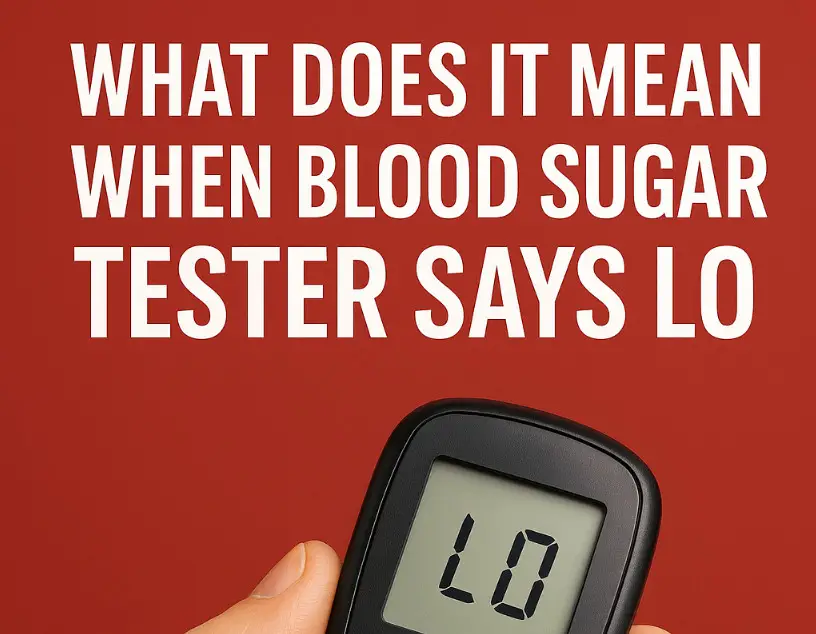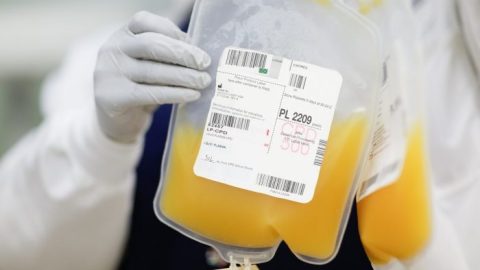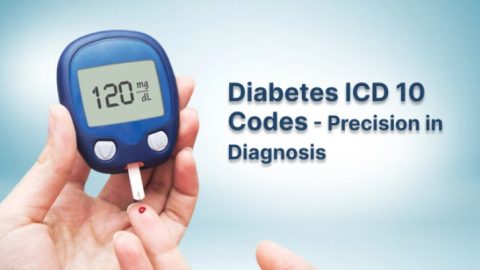Monitoring blood sugar is a daily routine for millions of people around the world, especially those living with diabetes. Glucose meters provide quick and reliable readings that help guide food choices, insulin doses, and lifestyle decisions. Yet, sometimes the device may display something unexpected: the screen simply reads “LO.”
For many, this result sparks confusion or alarm. Does it mean the tester is broken? Or does it signal a dangerously low blood sugar level? The answer can be life-saving. Understanding what a LO reading means, why it happens, and how to respond is crucial for anyone relying on a glucose meter.
This comprehensive guide explores the meaning of a LO result, the science behind glucose meters, the health risks of severely low blood sugar, and the steps you can take to stay safe.
How Blood Sugar Testers Work

The Basics of Glucose Monitoring
Blood sugar testers, also known as glucose meters, measure the concentration of glucose in a drop of blood, usually taken from the fingertip. The blood is placed on a disposable test strip, which contains special chemicals. These chemicals react with glucose and produce an electrical signal. The meter then interprets this signal and displays a number that represents the blood glucose level.
The technology has advanced over the years. Early devices were bulky and required larger blood samples, while modern meters are compact, need only a small drop of blood, and deliver results in just a few seconds. Despite improvements, they all share one limitation: they can only measure glucose within a certain range. Anything below that range is displayed as LO.
Measuring Units and Ranges
In the United States, blood sugar is measured in milligrams per deciliter (mg/dL), while in many other countries, the unit is millimoles per liter (mmol/L). A typical glucose meter can measure blood sugar levels between about 20 mg/dL and 600 mg/dL. When glucose falls below the lower limit, usually around 20 mg/dL, the meter shows LO. This does not mean your sugar is exactly 20 mg/dL—it could be even lower.
Accuracy and Standards
Glucose meters are regulated to meet accuracy standards. The U.S. Food and Drug Administration requires that most results be within 15% of a laboratory reference value. While these devices are not as precise as lab tests, they are accurate enough for daily management. Still, factors like improper strip storage, dirty fingers, or insufficient blood can influence results.
What Does a LO Reading Mean?
Severe Hypoglycemia Indication
A LO result usually indicates that your blood glucose has dropped below 20 mg/dL (1.1 mmol/L), which is dangerously low. This condition is known as severe hypoglycemia. The brain relies almost exclusively on glucose for energy, and when levels fall too low, brain function quickly deteriorates. This is why hypoglycemia can cause confusion, seizures, and loss of consciousness.
Not Always a Medical Reading
While LO usually points to very low blood sugar, it can sometimes be a testing error. If there wasn’t enough blood on the strip, if the strip is expired, or if the meter is malfunctioning, the device may show LO. For this reason, it is always recommended to wash your hands, retest, and confirm the result.
Normal vs. Low Blood Sugar Levels
Standard Ranges
For healthy individuals, blood sugar before eating is typically between 70 and 99 mg/dL (3.9–5.5 mmol/L). Two hours after eating, it should generally remain below 140 mg/dL (7.8 mmol/L). Diabetes targets may differ, but most guidelines still aim to keep blood sugar above 70 mg/dL to avoid hypoglycemia.
A LO reading signals a value far below even the lowest safe threshold. To put it in perspective, mild hypoglycemia begins below 70 mg/dL, while severe hypoglycemia is defined as below 54 mg/dL. When the meter reads LO, the blood sugar has plunged past the measurable limit, suggesting extreme danger.
Why the Brain Is at Risk
Unlike muscles, which can use fat for energy, the brain depends almost entirely on glucose. When glucose supply drops, brain cells cannot function normally. This explains symptoms like dizziness, confusion, difficulty speaking, or loss of consciousness. Prolonged or repeated episodes of severe hypoglycemia can even cause long-term neurological problems.
Common Causes of a LO Reading
Medication-Related Causes
The most frequent cause of LO in people with diabetes is too much insulin. Insulin helps lower blood sugar, but an excessive dose can drive levels down too far. Similarly, some oral diabetes medications, such as sulfonylureas, stimulate the pancreas to release insulin and can also cause hypoglycemia.
Skipping or Delaying Meals
Food provides glucose. Skipping a meal, delaying eating after taking insulin, or not consuming enough carbohydrates can quickly lead to dangerously low blood sugar. This is especially risky for those using long-acting insulin or insulin pumps.
Intense Physical Activity
Exercise burns glucose for energy. Without proper planning, a long workout or even unplanned physical activity can deplete glucose reserves and lead to hypoglycemia. Sometimes, blood sugar drops several hours after exercise, making nighttime hypoglycemia a concern.
Alcohol Consumption
Drinking alcohol without food can lower blood sugar because the liver focuses on metabolizing alcohol rather than releasing glucose into the bloodstream. Hypoglycemia from alcohol can appear several hours after drinking, even during sleep.
Device or Testing Errors
Not every LO result reflects true hypoglycemia. Inadequate blood samples, damaged strips, or meter malfunctions can trigger a false reading. Retesting is essential to distinguish between real and error-related results.
Symptoms of Hypoglycemia
Early Warning Signs
The body has defense mechanisms to alert you when blood sugar is falling. Many people first experience shakiness, sweating, rapid heartbeat, irritability, or sudden hunger. These are the body’s alarm signals that glucose is dropping.
Moderate Hypoglycemia
As glucose falls further, the brain begins to struggle. Symptoms may include blurred vision, difficulty concentrating, headache, and weakness. At this stage, immediate action is necessary to prevent progression to severe hypoglycemia.
Severe Hypoglycemia
When glucose dips into the dangerously low range, confusion deepens, speech may slur, seizures may occur, and loss of consciousness becomes a real possibility. A LO reading on a glucose meter often corresponds to this stage and requires urgent treatment.
Real-Life Scenarios When LO May Appear
A person may wake up in the morning with LO if they took too much long-acting insulin the night before. Someone who exercises vigorously without adjusting insulin or eating carbohydrates may see LO after finishing their workout. A person who drinks alcohol before bed without eating may also wake during the night to a LO reading. Each scenario highlights how lifestyle factors, medication, and timing interact to influence blood sugar levels.
What to Do When Your Blood Sugar Tester Says LO
Confirm the Result
The first step is always to wash your hands and test again. This rules out error caused by contaminated fingers or insufficient blood. If LO appears again, assume it is real and treat it as an emergency.
Immediate Treatment
Treating severe hypoglycemia requires fast-acting carbohydrates. Glucose tablets, fruit juice, or regular soda are effective. After consuming sugar, retest after 15 minutes. If blood sugar is still low, repeat the process.
Emergency Measures
If you are unable to swallow or lose consciousness, someone should administer glucagon, an emergency hormone that raises blood sugar. Family members, friends, or caregivers should be trained in its use. If glucagon is unavailable, or if recovery does not occur quickly, emergency medical services should be contacted immediately.
Long-Term Risks of Repeated LO Episodes
Frequent severe hypoglycemia is not just an acute danger. Over time, it can lead to hypoglycemia unawareness, a condition where warning symptoms diminish. This makes episodes more unpredictable and dangerous. Repeated low blood sugar can also stress the heart, raising the risk of arrhythmias or cardiac events. Cognitive function may also decline with recurrent severe episodes. For these reasons, preventing LO events is just as important as treating them.
Preventing LO Readings
Balanced Meal Planning
Eating regular meals and snacks that include sufficient carbohydrates is essential for preventing hypoglycemia. Pairing carbs with protein or fiber helps stabilize blood sugar.
Adjusting Medications Safely
Work closely with your healthcare provider to adjust insulin or medication doses. Self-adjusting without guidance can increase the risk of both high and low blood sugar.
Smart Exercise Habits
Plan exercise carefully. Eat a carbohydrate snack before vigorous activity, monitor your blood sugar during long workouts, and check again several hours later to avoid delayed hypoglycemia.
Alcohol and Safety
If you drink alcohol, always do so with food, and monitor your blood sugar more frequently afterward. Be aware that nighttime lows are especially common after drinking.
Technology for Prevention
Continuous glucose monitors (CGMs) provide real-time tracking and alerts when blood sugar is trending low. These devices are especially useful for those who experience frequent or severe hypoglycemia.
When to Seek Medical Help
Anyone who experiences frequent LO readings should speak with a healthcare provider. Adjustments to medication, meal planning, or lifestyle may be necessary. If LO readings occur without obvious cause, more advanced testing may be required to rule out other medical conditions. A single episode of severe hypoglycemia is concerning, but repeated episodes demand professional guidance.
FAQs About LO Readings
Is a LO reading always real?
Not necessarily. While it often indicates dangerous hypoglycemia, errors such as insufficient blood or faulty strips can also cause the reading. Retesting is the best way to confirm.
Can severe hypoglycemia be fatal?
Yes. If untreated, extremely low blood sugar can cause seizures, coma, or death. That is why immediate treatment is so critical.
What if I feel fine but the meter shows LO?
Even without symptoms, a confirmed LO reading means your blood sugar is critically low. Hypoglycemia unawareness can prevent you from noticing symptoms. Always treat the reading seriously.
How can I stop LO readings from happening?
Prevention involves balancing medication, meals, and activity. Using technology like continuous glucose monitors, carrying fast-acting carbs, and educating family members all play a role in staying safe.
Final Thoughts
Seeing “LO” on your blood sugar tester is a serious warning sign that your glucose is critically low, often below 20 mg/dL. While sometimes it may be caused by a testing error, it usually indicates severe hypoglycemia that requires immediate attention.
By understanding what this reading means, recognizing symptoms, and knowing how to respond, you can reduce the risks of complications. Consistent monitoring, balanced meals, safe medication use, and emergency preparedness are the best ways to prevent dangerous drops in blood sugar.
If you experience frequent LO readings, work closely with your healthcare provider to adjust your diabetes management plan. Protecting yourself against hypoglycemia is an essential part of maintaining long-term health and well-being.



